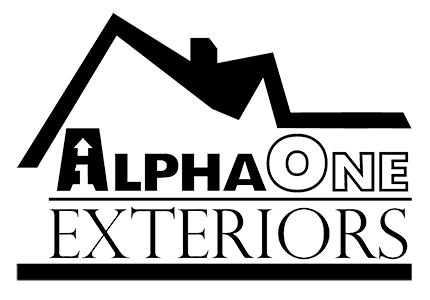When snow or ice accumulates on your roof during the winter, roof leaks often follow. While these leaks may appear to come from the roof itself, they’re often caused by a hidden problem: ice damming. If you’re in the Dayton, Ohio area, AlphaOne Exteriors has seen ice dams cause significant issues for homeowners, but do you know what they are and how they affect your roof?
In this article, we’ll discuss everything you need to know about ice dams, including what they are, how they cause roof leaks, and how to prevent and remove them.
What is an Ice Dam on a Roof?
An ice dam forms when snow and ice melt on your roof but are prevented from draining due to a buildup of ice at the roof’s edge, typically in the gutters. As the snow melts and refreezes, it creates a literal block of ice, blocking water from draining properly off the roof.
You can spot ice dams by large icicles hanging from your gutters. Ice dams commonly form at the gutter line, but they can also develop in roof valleys, around a roof cricket, or where a valley meets a wall (called a deadpan valley). Ice dams in roof valleys can be harder to identify since they may be covered by snow until the thaw begins.
How Do Ice Dams Cause Roof Leaks?
Ice dams block the natural flow of water off your roof. When snow melts, the water can’t drain properly, and it backs up, pooling on your roof’s surface. This standing water eventually seeps under your roofing materials and can lead to leaks inside your home.
The leak may not become apparent until the ice dam begins to thaw, but by then, significant water damage may have occurred. Unfortunately, once an ice dam has already formed and caused a leak, there’s nothing a roofer can do to prevent the immediate damage. However, there are ways to prevent future ice dams and leaks.
How to Prevent Roof Leaks Caused by Ice Dams
While there’s no quick fix for ice dam leaks once they’ve started, there are preventive measures you can take when replacing your roof. The most effective solution is to install ice and water shield along the roof’s edges (rakes and eaves). This material should extend at least 2 feet beyond the interior walls of your home to prevent water from seeping under the roofing materials.
If you can’t install a shield along the entire perimeter, it’s recommended to focus on roof valleys. For deadpan valleys, installing a metal or membrane material in the valley or along the wall can help prevent water from leaking into cracks.
At AlphaOne Exteriors, we specialize in providing these solutions to prevent ice damming and the leaks that come with it. Our team can help ensure your roof is properly equipped to handle the harsh winter weather.
Can You Prevent Ice Dams from Forming?
While completely preventing ice dams isn’t always possible, there are several steps you can take to minimize the likelihood of their formation:
- Insulate Your Attic: Proper insulation prevents warm air from escaping through the roof, keeping the roof temperature consistent with the outside temperature, which helps prevent snow from melting and refreezing.
- Ensure Proper Ventilation: A well-ventilated attic expels warm air and helps maintain a cool attic, reducing the chances of ice dams forming.
- Clear Debris from Gutters: Debris in gutters can obstruct water drainage, making ice buildup worse. Keeping your gutters clean can help prevent this.
- Maintain Roof and Gutter Health: By regularly clearing debris from your roof and gutters, you reduce the chance of ice buildup, which can exacerbate the formation of ice dams.
At AlphaOne Exteriors, we provide expert roofing solutions, including attic insulation and proper attic ventilation, to help reduce the risk of ice dams. Our team is committed to keeping your roof safe and functional during the winter months.
How Do You Remove Ice Dams from Your Roof?
If an ice dam has already formed on your roof, it’s important to address it safely. While some homeowners try to clear ice dams themselves using hot water, hoses, or rakes, this is highly risky and can damage your roof.
Instead, use a roof rake to remove snow from your roof, or contact a professional, like the team at AlphaOne Exteriors, to handle the job. Specialized tools are essential for safely removing snow and ice without causing harm to your roof.
In some areas, heat cables can be installed on roofs to prevent ice dams from forming in the first place. However, these systems come with potential risks, including fire hazards, so they should be used with caution.
Does Homeowners Insurance Cover Ice Dams?
Homeowners insurance typically does not cover the formation of ice dams, but it may cover damages caused by water leaking through the roof. Depending on your policy, insurance might cover structural damage or personal property damage caused by the leak.
Check your policy and speak with your insurance agent to understand if your coverage includes ice dam-related water damage and what steps you should take to file a claim.
Are You Dealing with Roof Leaks Due to Ice Dams?
Now you understand what ice dams are, how they cause roof leaks, and how to prevent them. If you’re experiencing a leak due to ice damming, it’s best to keep a bucket nearby to catch any water. Avoid trying to remove ice dams yourself, as this can cause further damage.
Instead, contact AlphaOne Exteriors, an experienced roofing company, to install preventative measures and ensure your roof is protected from ice damming. With the right steps, you can protect your home from costly water damage.
